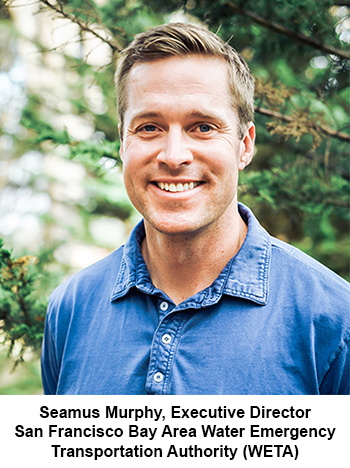On Board With… WETA Executive Director Seamus Murphy
Seamus Murphy is the Executive Director of the San Francisco Bay Area Water Emergency Transportation Authority (WETA), which operates SF Bay Ferry service throughout the region.
Prior to joining WETA, Murphy spent over a decade overseeing external affairs and strategic communications for the San Mateo County Transit District (District), which operates the Caltrain commuter rail system and SamTrans bus service. As the District’s Chief Communications Officer, Murphy led efforts to secure funding for transformative projects including the $2 billion Caltrain Electrification Project. He was also responsible for passing state legislation that paved the way for voter approval of revenue measures creating over $200 million/year in new transportation investment for improvements and services throughout the Peninsula.
Murphy has been recognized as a leader focused on building strong coalitions that can effectively advocate for solutions to the industry’s most pressing challenges. He is a recipient of Mass Transit Magazine’s “Top 40 Under 40” award and is a key player in local, regional, state, and national efforts to sustain, improve, and expand public transportation for all who depend on it.
 Transit California:
Transit California:
You became the newest member of the Association’s Executive Committee in 2022. Why is it important that you have joined the committee?
Seamus Murphy:
I was really excited to hear that the Association created a seat on the Executive Committee for ferry and rail operators. The Association does an amazing job advocating for transit statewide, and this seat helps ensure that the full spectrum of the State’s modes is represented as a part of that effort.
Transit California:
You became Executive Director of the San Francisco Bay Area Water Emergency Transportation Authority (WETA) in 2021. Of what accomplishments are you most proud in your almost two years in this role?
Seamus Murphy:
The industry has obviously faced unprecedented challenges over the last few years. Those challenges are going to continue for some time, and I’m proud of how the team at WETA has responded. Instead of waiting, and hoping that ridership would return, we took proactive steps to incentivize it, and to maximize the relevance of our system during pandemic recovery.
Thanks to federal COVID relief funding, WETA was able to become the first system in the Bay Area to fully restore service. We also reinvented our network, with a focus on off-peak service and the alignment of our fares with other transit modes. The result was a dramatic and immediate increase in ridership. We proved that there was latent demand just waiting for service to return, and we diversified our customer base by allowing riders to focus less on cost and more on choosing the travel mode that works best for them.
These strategies have helped restore almost 80 percent of pre-pandemic ridership, but we are still a long way from where we need to eventually be.
Transit California:
What are some of your priorities for WETA moving forward?
Seamus Murphy:
It’s likely that our service will need to evolve even more. Like other fare-dependent systems, WETA was heavily reliant on office-based commuters. Remote work will have a long-term and probably permanent impact on our business model. To maximize our ability to create new markets, WETA is moving quickly to establish new services to areas where waterfront development is booming and water transit will be the travel mode of choice.
We are also wrapping up work on a Business Plan that evaluates long-term service options and how they align with different ways that travel patterns are likely to evolve. Our network today is a hub and spoke system that worked great to connect Bay Area communities with downtown San Francisco. In the future, the network that works best might look more like a spider web, with new origin-and-destination pairings throughout.
Transit California:
WETA is a national leader in the transition to zero-emission transit. Why has your agency taken this role?
Seamus Murphy:
The U.S. is lagging behind the rest of the world when it comes to reducing maritime emissions. Norway started seven years ago and has 84 battery-electric vessels in operation. The U.S. has maybe a handful, and none of them are high-speed ferries. To help catch up, WETA developed a fleet plan that meets the state’s emission reduction targets by focusing on the adoption of zero-emission vessels. Over the last three years, we’ve secured funding for five battery-electric vessels, and we’re on track to be the first system in the country to put one in service. Our goal is to make the transition and also maintain or improve customer experience. That goal will only be possible if federal and state investment in transit decarbonization continues to drive technology advancements.
Transit California:
In July of this year, WETA was awarded a $14.9 million grant from the California State Transportation Agency (CalSTA) to develop the San Francisco Clean Ferry Network. How were you able to win this grant?
Seamus Murphy:
It helps that the project is perfectly aligned with the goals of the State’s grant program and also has a lot of public support. If all goes well, we will hear good news soon about new awards that focus on our East Bay services.
Transit California:
Your position on the Executive Committee represents rail as well as ferry operators. How are you able to represent both modes?
Seamus Murphy:
There are a lot of parallels between the two modes: similar markets; similar operating constraints. The State Rail Plan spells out why investment in an improved, integrated rail network is critical if we want to maximize mode shift from cars to transit. That progress starts with investment in upgrading our existing systems throughout the state. Before joining WETA, I spent 10 years with Caltrain helping to advance some of that work. We passed ballot measures, won lawsuits, and navigated some really challenging funding threats in that time. I also think we built one of the strongest rail advocacy coalitions around. I’m excited that I still get to be a part of it.